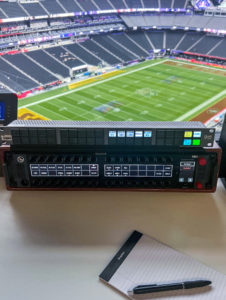2024 is shaping up to be a prominent year in the world of sports. With the Olympics and Paralympics set for Paris this Summer, Euro 2024 heading to Germany in June, and the Formula One returning for its annual World Championship, there is something for every sports fan happening this year.
Anyone who has experienced the thrill of a live sporting event knows that the atmosphere is not one that can be easily replicated away from the action. Yet, in the grand scheme of things, only a small percentage of consumers watch the games and matches in-person. The rest of the population rely on TV or the internet to cheer their favourite team on.
To put this into context, the 2024 Super Bowl had an in-person attendance of 61,629 – a very small number compared to the 123.7 million broadcast viewers.
And it’s not just the live coverage that broadcasters have to worry about – consumers want additional content: social media clips, documentaries, player biopics, behind-the-scenes footage. So, how can sports broadcasters create immersive experiences that keep the home viewers engaged and fulfilled?
Turn to the archives
The one thing sports broadcasters have a lot of is footage! Decades’ worth of historic sports content is now showing its true value. Delivering re-runs of the most memorable matches and moments to fans is a great way to raise spirits among viewers. Utilizing what already exists in the archives, broadcasters can showcase the bonus content that viewers want, helping them tap into additional markets, reach new audiences, and maximize their monetization options.
Can tech improve how archived footage is delivered?
Delivering this archived coverage to fans brings its own challenges. Knowing what you have in your archives isn’t easy, even at the best of times, if you’re having to manually search the tapes warehouse for it.
The very nature of archived footage tends to mean that much of it is stored on physical copies, and although this has its benefits, it doesn’t suit the fast turnaround of content needed in today’s broadcast landscape. LTO archives require a manual approach which presents challenges for teams working from different locations. Instead, dispersed teams need self-serve access to their content from anywhere. Preferably using future-proof storage solutions which facilitate automation and that can integrate with asset management and other workflow tools.
Transferring your content onto an online system means that creative teams can access content from anywhere in the world. Even better, thanks to metadata and intelligent media asset management technology, you can quickly search and retrieve content from certain years or tournaments or featuring certain athletes and teams. Once located in your archive, your required footage will be ready and available within seconds.
Could archived sports footage finally reach its full potential?
There’s no doubt that fans are appreciating the value of archived content. Being able to watch memorable sporting moments – from a rugby players’ top 10 tries to key highlights from the 1980 Summer Olympics – on demand is huge for broadcasters and consumers. Broadcasters get to reuse existing content, and viewers get to enjoy more of what they love.
Looking ahead, there is a huge role for archived content within sports broadcasting. And the technology is out there to help broadcasters fully utilize their archived content and deliver high-quality media without having to spend hours hunting and editing the content.









